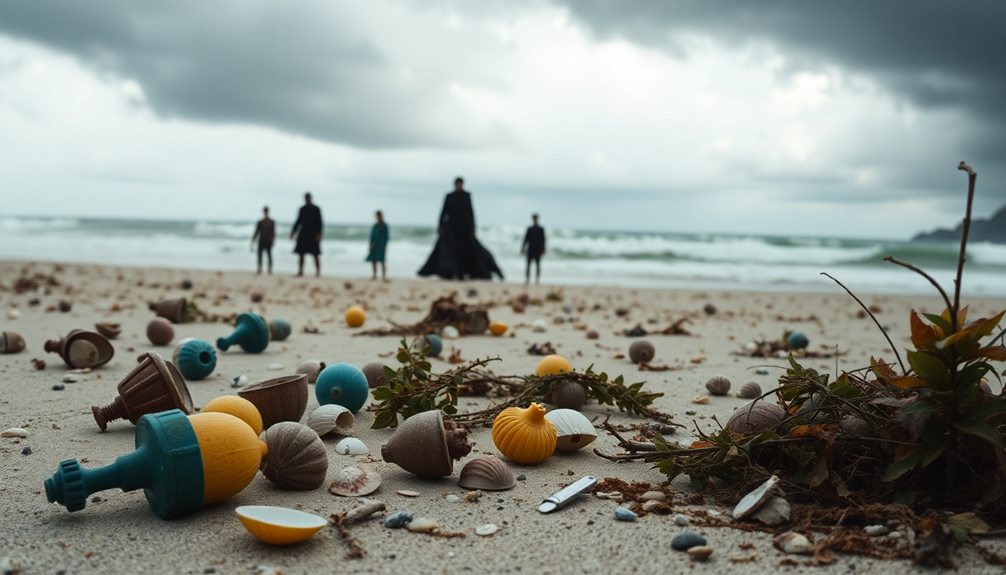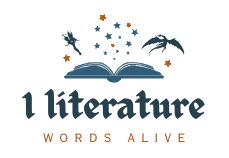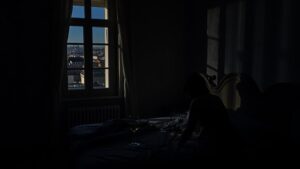In "Lord of the Flies," you witness the rapid decline of civilization as a group of boys transforms from innocent children into savage hunters. William Golding explores human nature, highlighting how easily societal norms can break down under pressure. The conflict between Ralph, who represents order, and Jack, who embodies savagery, illustrates this struggle. Characters like Piggy and Simon reveal the complexities of morality and intellect in chaotic environments. As the boys confront their inner darkness, the story reveals uncomfortable truths about humanity. If you want to uncover deeper insights, you might find the following discussion enlightening.
Background of the Novel
In the wake of World War II, William Golding's "Lord of the Flies," published in 1954, offers a stark contrast to the idealized portrayal of boys found in R.M. Ballantyne's "The Coral Island." While Ballantyne depicts boys stranded on an island as innocent adventurers, Golding reveals their descent into chaos and savagery. His experiences during the war fueled skepticism about human nature and society, leading him to explore the darkness within humanity.
The novel illustrates how the breakdown of societal norms can lead to a rapid descent into violence, exposing the primal instincts that lie dormant within us all, reflecting the fragility of moral order.
Golding draws on Sigmund Freud's theories of inherent evil, suggesting that civilization's veneer can easily shatter when order is stripped away. In "Lord of the Flies," the boys, isolated from adult supervision, grapple with their primal instincts, ultimately highlighting the fragility of societal norms.
As they attempt to establish their own civilization, their efforts devolve into chaos, exposing the darker aspects of their nature. This narrative serves as an allegory for the broader themes of civilization and morality, challenging the notion that humans are inherently good.
Through this lens, Golding invites you to confront the uncomfortable truths about human nature and the potential for evil lurking within us all.
Key Themes Explored
In "Lord of the Flies," you see how inherent human evil emerges when societal rules disappear.
The clash between civilization and savagery plays out through the characters of Ralph and Jack, highlighting the thin veneer of order.
This mirrors the themes found in classic literature, such as the exploration of class struggles and the resilience of the human spirit in Dickens' "David Copperfield."
As you explore these themes, you'll recognize the darkness within humanity and the fragile nature of societal structures.
Inherent Human Evil
William Golding's "Lord of the Flies" starkly reveals the inherent evil lurking within human nature as the boys descend into chaos without societal constraints. The boys who are stranded on the island initially attempt to establish order, but as fear and primal instincts take over, they begin to embody their true natures.
Jack represents this inherent evil, using manipulation and mob mentality to incite savagery over civilization. The loss of innocence becomes evident as the boys abandon their moral compass, succumbing to the darkness within.
The "beast" symbolizes the boys' inner fears, illustrating that the true source of evil isn't an external force, but rather an intrinsic part of human nature. Simon's realization that the beast isn't a monster but a representation of their own savagery emphasizes this point.
Meanwhile, the tragic fate of Piggy, who symbolizes intellect and reason, highlights the fragility of moral order. As savagery triumphs over civilization, Golding forces you to confront the unsettling truth about humanity: beneath the veneer of society lies an ever-present potential for inherent evil.
Civilization Versus Savagery
Amidst the idyllic setting of the island, the struggle between civilization and savagery unfolds dramatically through the characters of Ralph and Jack. Ralph represents the desire for order and the establishment of a moral framework, symbolized by the conch shell, which initially brings the boys together.
However, as fear and chaos seep into their lives, this fragile civilization rapidly deteriorates. Jack, embodying primal instincts, capitalizes on this fear, leading the boys toward savagery and violence.
The conflict between these two forces highlights a central theme of human nature—the tension between the instinct to create a structured society and the urge to succumb to chaos. As the boys embrace hunting and brutality, they abandon their moral order, culminating in the tragic murder of Piggy.
This act symbolizes the complete breakdown of civilization and the triumph of savagery. The "beast" becomes a powerful representation of the innate darkness within each of them, illustrating how easily fear can dismantle the fragile constructs of order.
Ultimately, "Lord of the Flies" argues that civilization is tenuous, revealing the unsettling reality of human nature when faced with primal instincts.
Analysis of Human Nature

Many readers find that "Lord of the Flies" starkly reveals the darker aspects of human nature, prompting a deep examination of our primal instincts. Golding suggests that inherent evil lurks within each of us, waiting for the right conditions to emerge. Without the constraints of society and civilization, individuals like Jack and Ralph illustrate the struggle between savagery and order. Their conflict highlights the power dynamics that shape human interactions and moral choices.
Similar to the forbidden love explored in *The Thorn Birds*, the tensions between personal desires and societal expectations can lead to a moral unraveling.
The symbolic "beast" serves as a mirror, reflecting the darkness within the boys and their fears. As they confront this inner turmoil, chaos ensues, showcasing how external forces can exacerbate their inherent savagery. The boys' descent into violence marks a profound loss of innocence, illustrating Golding's critique of the noble savage ideal. Civilization, as portrayed in the novel, is fragile and easily disrupted by our base instincts.
Ultimately, Golding emphasizes that evil isn't an alien force but an intrinsic part of human identity. By exploring these themes, "Lord of the Flies" challenges you to confront the unsettling reality of human nature and the potential for darkness that lies within us all.
The Role of Leadership
Golding illustrates how leadership shapes the dynamics of power and morality among the boys on the island. Ralph, elected as leader, embodies democratic values, endeavoring to maintain order through collective decision-making. His leadership fosters a sense of responsibility, crucial for a functioning society.
In contrast, Jack's authoritarian style emerges, transforming from a choirboy to a figure who manipulates fear to gain power and followers. This shift reveals the allure of savagery and chaos that often undermines democratic ideals, much like the struggles faced by families in immigrant communities depicted in early 20th-century Brooklyn.
Piggy stands as the voice of reason, representing intellect and rational thought. Unfortunately, his insights are often marginalized, highlighting how essential logical perspectives can be vulnerable in chaotic environments.
The conflict between Ralph's democratic approach and Jack's tyrannical rule underscores the fragility of democratic values, illustrating how quickly they can erode in the face of primal instincts.
The conch shell symbolizes authority and order in leadership, initially enabling civil discourse and governance. However, as its power wanes and ultimately gets destroyed, it signifies the complete breakdown of societal structure and moral leadership.
This shift starkly illustrates the struggle between different leadership styles and the consequences they've on the boys' society.
Savagery vs. Civilization

As you explore "Lord of the Flies," you'll notice how the tension between savagery and civilization unfolds dramatically throughout the narrative. The boys' descent into savagery, particularly through Jack's rise to power, showcases how fear and primal instincts can manipulate human nature. This mirrors the acts of courage and defiance seen in historical resistance movements, where individuals faced oppressive forces and chose to stand firm against tyranny.
Jack's authoritarian rule rejects the civilized order Ralph tries to uphold, revealing the fragility of moral codes in the face of chaos. The signal fire symbolizes hope and connection to civilization, but as the boys neglect it, they increasingly embrace savagery. This shift highlights their abandonment of structure and the emergence of darker instincts.
The beast, representing their primal fears, intensifies this struggle, illustrating how easily chaos can overwhelm order when societal constraints disappear. Ralph's leadership stands in stark contrast to Jack's, emphasizing the conflict between cooperation and the thirst for power.
While Ralph seeks to maintain civilization through democratic values, Jack thrives on chaos and division. Ultimately, Golding presents a chilling view of human nature, suggesting that beneath the veneer of civilization lies a potential for savagery, waiting to erupt when fear and power dynamics take control.
Character Transformations
In "Lord of the Flies," character transformations vividly illustrate the shift from innocence to savagery among the boys. Ralph, who initially represents order and democratic leadership, struggles to maintain civilization as chaos erupts around him. His character arc reveals the difficulties of asserting authority when primal instincts take over, much like Liesel's journey in resilience amidst adversity.
On the other hand, Jack starts as a choirboy but quickly morphs into a tyrant, embracing savagery and manipulation to seize power. This transformation highlights the seductive nature of human instincts.
Piggy serves as the voice of reason, symbolized by his glasses, which represent knowledge and clarity. However, his tragic fate underscores the loss of civilization, showing how intellect can be marginalized in a chaotic environment.
Simon, embodying innate goodness, contrasts sharply with the others, ultimately revealing that the true source of evil lies within themselves.
The character arcs throughout the novel emphasize the tension between civilization and savagery, demonstrating the complexities of human nature. As the boys descend into violence, their transformations reflect the dark potential that resides in us all, serving as a cautionary tale about the fragility of civilized order.
Modern Relevance and Lessons

The lessons from "Lord of the Flies" resonate powerfully in today's world, reminding us that civilization's veneer can easily crack under pressure. In our chaotic times, the novel serves as a cautionary tale about the fragility of civilization and the inherent evil lurking within human nature. You can see this reflected in modern society, where power dynamics and corruption can lead to the descent into savagery, much like the boys on the island.
The dark allure of obsession and the relentless pursuit of desires, as seen in the consequences of manipulation, parallels the boys' descent into chaos and highlights how unchecked fixation can unravel lives.
The themes of mob mentality and group behavior are especially relevant today, as social movements often illustrate how individuals can lose their moral compass in a collective frenzy. This loss of individual responsibility highlights the need for ethical leadership, guiding us back toward order amidst chaos.
Golding's insights prompt you to reflect on the balance between personal desires and the greater good. The symbolic elements, such as the conch shell and the beast, remind us of the ongoing struggle between civility and chaos.
In understanding these complexities, you gain a deeper awareness of the dynamics at play in your own interactions and the importance of maintaining order in society.
Conclusion
In "Lord of the Flies," you see how fragile civilization can be when stripped away. This echoes today's social media dynamics, where anonymity can lead to toxic behavior, much like the boys on the island. Just as Ralph struggles to maintain order, you might find communities facing similar challenges online. By reflecting on these themes, you're reminded of the importance of empathy and responsibility in human interactions, both in literature and in your daily life.



